|
  Above: Romagnola
are basically gentle with calm dispositions. Above: Romagnola
are basically gentle with calm dispositions.
|
|
Ultrasound and slaughter data indicates that Romagnola produce
very little in the way of outside fat, in most cases less than 0.2
inches, and no seam fat. Commercial packing house data indicates
that crossbred offspring carry this same trait.
|
 |
Romagnola are muscular cattle without any double-muscling. The
muscling on top, along the loin where the Choice cuts are,
will reach 14 to 16 square inch ribeye at 1,200 lbs in 11-12
months in reasonable conditions.
|
|
|
The muscle fiber in Romagnola is extremely fine-grained and more
genetically tender than the muscle of conventional breeds of cattle.
This accounts for the demand for Romagnola and Romagnola cross
cattle on the part of many branded beef programs.
Romagnola meat is very tender and tasty. A thin rind of back fat
with a light flecking of marbling infused in the muscle sets off the
obvious quality of a good steak or roast. The beef butchers have
been looking for this quality beef: low fat, but still full of
flavor and tenderness that cuts at least 65% from carcass.
Romagnola beef is very different than most other domestic breeds in
that the muscle fiber diameter is smaller, and because of the volume of
muscle they possess, Romagnola bulls will increase ribeye area on almost
any cross. As far as backfat and marbling are concerned, it’s not
uncommon for Romagnola cattle to have point two (0.2) inches of backfat or
less and still have enough marbling to grade Choice. Romagnola marbling
is dispersed across the entire ribeye in very fine flecks, as opposed to
some other breeds where you can get large deposits of fat or seam fat
around the muscle area.
|
|
 Underlying the silver hair on the Romagnola is a black hide, and
the gene for color is recessive; a calf sired by a Romagnola bull
will usually be the same color as the cow. This means a
black cow will produce a black calf. Pictured at left is a Romagnola
X Angus (RomAngus) calf. Underlying the silver hair on the Romagnola is a black hide, and
the gene for color is recessive; a calf sired by a Romagnola bull
will usually be the same color as the cow. This means a
black cow will produce a black calf. Pictured at left is a Romagnola
X Angus (RomAngus) calf.
|
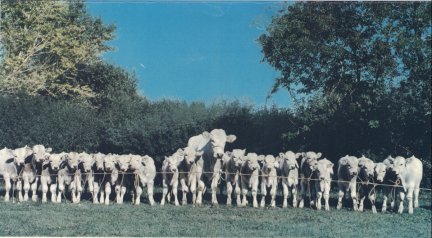 Romagnola cattle are very fertile. The cow to the left produced 26 embryos and from those embryos, produced 20 calves in one flush. The single most economic trait in the Beef Cattle Industry is the ability of a cow to give birth to her first calf at two years of age and then give enough milk to raise it on her own. Her second, and each calf afterward, should arrive within 12 month intervals. Romagnola cattle are very fertile. The cow to the left produced 26 embryos and from those embryos, produced 20 calves in one flush. The single most economic trait in the Beef Cattle Industry is the ability of a cow to give birth to her first calf at two years of age and then give enough milk to raise it on her own. Her second, and each calf afterward, should arrive within 12 month intervals.
|
|
 Romagnola bulls are athletic, aggressive breeders that will breed cows in any climate. Pictured
at left is a Romagnola bull breeding cows in Mexican cactus country. Romagnola bulls are athletic, aggressive breeders that will breed cows in any climate. Pictured
at left is a Romagnola bull breeding cows in Mexican cactus country.
|
|
A powerful Romagnola bull bred to a regular cow will give you a
great offspring with, under normal conditions, no calving
difficulty.
Romagnola calves are long and tubular, with low birth weights. A
long, tubular 85lb calf is easier to calve than a 70lb short,
compact calf. Most naturally
produced fullblood Romagnola and Romagnola crosses calve in the 65
to 85 pound range.
Romagnolas have an average mature weight in the range of 1,700
to 2,200 pounds. On good grass, calves will wean in the 600 to 700
pound area at 6 1/2 to 7 months.
|
|
 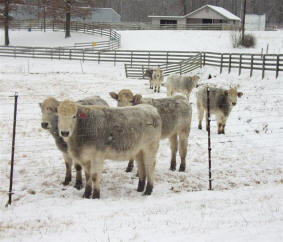 Above and at Left: Romagnola handle heat and humidity, as
well as extreme cold very well.
There is an underlying strain of Bos Indicus in the ancient
Romagnola proven by blood typing that allows them to function well
under extreme climatic conditions. Romagnola Cattle are known for
their “Easy Keeping” and it is not at all unusual for a fifteen year
old cow to have an udder that resembles that of a young four year
old. Their teats are tucked-under, to allow grazing in
cactus and prickly vegetation.
Above and at Left: Romagnola handle heat and humidity, as
well as extreme cold very well.
There is an underlying strain of Bos Indicus in the ancient
Romagnola proven by blood typing that allows them to function well
under extreme climatic conditions. Romagnola Cattle are known for
their “Easy Keeping” and it is not at all unusual for a fifteen year
old cow to have an udder that resembles that of a young four year
old. Their teats are tucked-under, to allow grazing in
cactus and prickly vegetation.
|
| Romagnola have a black pigment around the eyes that
virtually eliminates pinkeye. Their hooves are black and hard,
allowing them to travel easily over all types of terrain.
|
 The
photo above shows the hardiness of Romagnola influenced
cattle and their ability to make it in the real world, even on
cactus pastures. These cattle are surviving and doing well. The
photo above shows the hardiness of Romagnola influenced
cattle and their ability to make it in the real world, even on
cactus pastures. These cattle are surviving and doing well.
|
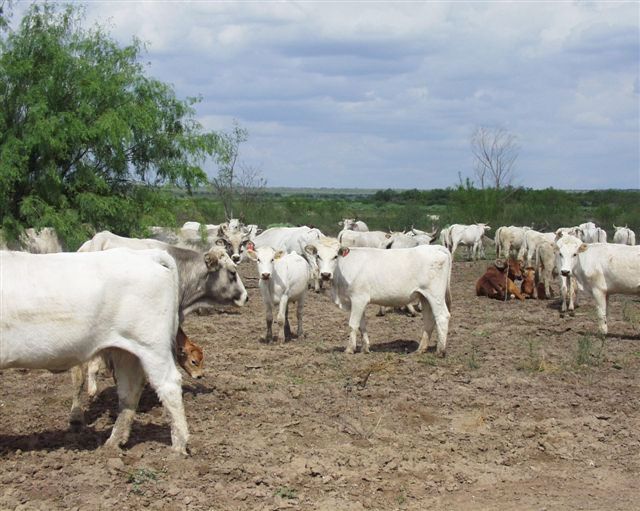 This
fullblood Romagnola herd is thriving and doing well in a Mesquite
Cactus pasture in Monterrey, Mexico. This
fullblood Romagnola herd is thriving and doing well in a Mesquite
Cactus pasture in Monterrey, Mexico. |
 This
is a Romagnola bull that will sire this group of fullblood Romagnola
females (in both above photos). These cattle are in good condition,
even in this dry environment. This
is a Romagnola bull that will sire this group of fullblood Romagnola
females (in both above photos). These cattle are in good condition,
even in this dry environment. |
 
 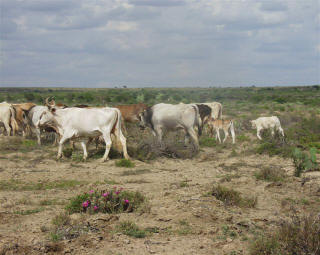 These
are photos of a bull produced from a fullblood Romagnola herd that
is siring Brahman crossbred cattle. The pictures above demonstrate
that Romagnola bulls will do well in extreme conditions. These
are photos of a bull produced from a fullblood Romagnola herd that
is siring Brahman crossbred cattle. The pictures above demonstrate
that Romagnola bulls will do well in extreme conditions. |
Below: A Group of Young Romagnola Bulls at
Cherokee Ranch
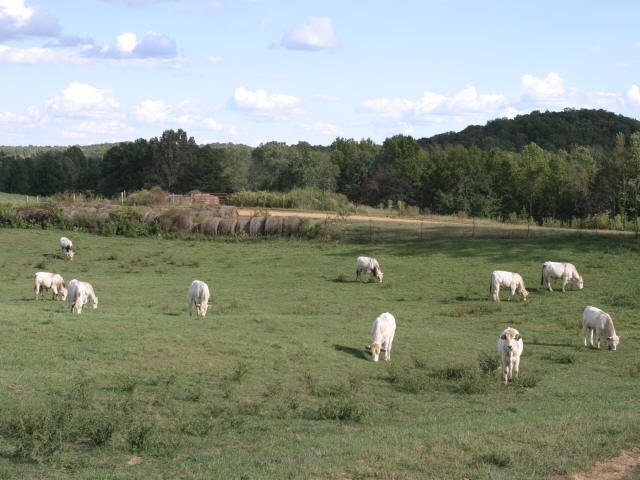 |

 Above: Romagnola
are basically gentle with calm dispositions.
Above: Romagnola
are basically gentle with calm dispositions. 
 Underlying the silver hair on the Romagnola is a black hide, and
the gene for color is recessive; a calf sired by a Romagnola bull
will usually be the same color as the cow. This means a
black cow will produce a black calf. Pictured at left is a Romagnola
X Angus (RomAngus) calf.
Underlying the silver hair on the Romagnola is a black hide, and
the gene for color is recessive; a calf sired by a Romagnola bull
will usually be the same color as the cow. This means a
black cow will produce a black calf. Pictured at left is a Romagnola
X Angus (RomAngus) calf. Romagnola cattle are very fertile. The cow to the left produced 26 embryos and from those embryos, produced 20 calves in one flush. The single most economic trait in the Beef Cattle Industry is the ability of a cow to give birth to her first calf at two years of age and then give enough milk to raise it on her own. Her second, and each calf afterward, should arrive within 12 month intervals.
Romagnola cattle are very fertile. The cow to the left produced 26 embryos and from those embryos, produced 20 calves in one flush. The single most economic trait in the Beef Cattle Industry is the ability of a cow to give birth to her first calf at two years of age and then give enough milk to raise it on her own. Her second, and each calf afterward, should arrive within 12 month intervals. Romagnola bulls are athletic, aggressive breeders that will breed cows in any climate. Pictured
at left is a Romagnola bull breeding cows in Mexican cactus country.
Romagnola bulls are athletic, aggressive breeders that will breed cows in any climate. Pictured
at left is a Romagnola bull breeding cows in Mexican cactus country.
 Above and at Left: Romagnola handle heat and humidity, as
well as extreme cold very well.
There is an underlying strain of Bos Indicus in the ancient
Romagnola proven by blood typing that allows them to function well
under extreme climatic conditions. Romagnola Cattle are known for
their “Easy Keeping” and it is not at all unusual for a fifteen year
old cow to have an udder that resembles that of a young four year
old. Their teats are tucked-under, to allow grazing in
cactus and prickly vegetation.
Above and at Left: Romagnola handle heat and humidity, as
well as extreme cold very well.
There is an underlying strain of Bos Indicus in the ancient
Romagnola proven by blood typing that allows them to function well
under extreme climatic conditions. Romagnola Cattle are known for
their “Easy Keeping” and it is not at all unusual for a fifteen year
old cow to have an udder that resembles that of a young four year
old. Their teats are tucked-under, to allow grazing in
cactus and prickly vegetation. The
photo above shows the hardiness of Romagnola influenced
cattle and their ability to make it in the real world, even on
cactus pastures. These cattle are surviving and doing well.
The
photo above shows the hardiness of Romagnola influenced
cattle and their ability to make it in the real world, even on
cactus pastures. These cattle are surviving and doing well. This
fullblood Romagnola herd is thriving and doing well in a Mesquite
Cactus pasture in Monterrey, Mexico.
This
fullblood Romagnola herd is thriving and doing well in a Mesquite
Cactus pasture in Monterrey, Mexico. This
is a Romagnola bull that will sire this group of fullblood Romagnola
females (in both above photos). These cattle are in good condition,
even in this dry environment.
This
is a Romagnola bull that will sire this group of fullblood Romagnola
females (in both above photos). These cattle are in good condition,
even in this dry environment.


 These
are photos of a bull produced from a fullblood Romagnola herd that
is siring Brahman crossbred cattle. The pictures above demonstrate
that Romagnola bulls will do well in extreme conditions.
These
are photos of a bull produced from a fullblood Romagnola herd that
is siring Brahman crossbred cattle. The pictures above demonstrate
that Romagnola bulls will do well in extreme conditions.